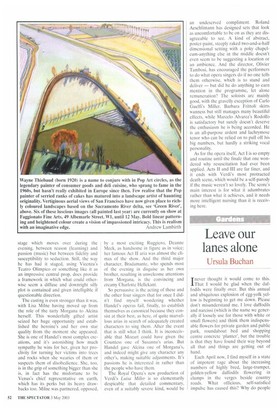Leave our lanes alone
Ursula Buchan
Inever thought it would come to this. That I would be glad when the daffodils were finally over. But this annual and ubiquitous explosion of egg-yolk yellow is beginning to get me down. Please don't misunderstand me, I love daffodils and narcissi (which is the name we generally if loosely use for those with white or small flowers) and think them indispensable flowers for private garden and public park, roundabout bed and shopping centre concrete 'planter', but the trouble is that they have found their way beyond all that and things are getting out of hand.
Each April now, I find myself in a state of impotent rage about the increasing numbers of highly bred, large-trumpet, golden-yellow daffodils flowering in clumps in the verges beside country roads. What officious, self-satisfied impulse has caused this? Why do people (and it surely cannot be county councils who have rather too many better things to spend their money on) feel that they are doing us all a favour by planting semi-natural places with budget sacks of 'Dutch Master' or 'Golden Harvest'? No doubt they have justified this crass act to themselves because it brightens the countryside up, and provides a welcome splash of colour amongst all those green leaves'. Along the verges of an otherwise pretty country road that I know, which is bounded by hawthorn, blackthorn, ash and oak, the mystery bulb planters have put in ribbons of red tulips as well. Mercifully, these are likely to die out in a couple of years, finding it hard to compete with long grass, but not so the daffodils which will survive and multiply_ Much of the beauty of our countryside lies in its understated quality. The 'Dutch Master' daffodil, on the other hand, is a statement of the blindingly obvious.
I would not mind half so much if they plumped for one of the native species (Narcissus obvallaris or N. pseudonarcissus) but the daffodils used are those with the longest trumpets, developed by assiduous breeders over 150 years, and they simply overawe their humbler, more delicate forebears. Modern daffodils are often tetraploid, for a start, which means that they have double the normal number of chromosomes and are substantially larger in all their parts. To succeed on the exhibition bench, and command high prices in the catalogues, a daffodil must have good form, especially symmetry of flower (in one plane) and poise, be pure in colour, with good texture, and without blemish. Much of the energy in daffodil breeding at the moment is concentrated towards broadening the colour range of petals (perianth) and trumpet or cup (corona), or improving the appearance of the 'splitcoronas', those daffodils whose trumpets are spread back hard against the perianths, which you could be forgiven for not recognising as daffodils at all.
A fortnight ago, at the Royal Horticultural Society's Daffodil Show at Wisley, the full range of modern hybrids was on show, highlighting the impressive capacity of this genus to mix its genes. The daffodil is classified into 13 divisions, with sub-classes depending on colour. So 'Moralee', for example, has the initially mystifying 4 Y-R classification, which simply means it is a double daffodil, with yellow and red petals intermixed.
The qualities required for the showbench are not necessarily those which will make good garden plants, but the fact that the RI-IS judges look for garden value — flowers which stand above the leaves, good weather resistance and colour fastness — when giving out awards after outdoor trials at Wisley, does influence the hybridists, and garden-worthiness and exhibition quality have not diverged so far as is the case with chrysanthemums, say. Most daffodils — with the exception of the 'split coronas' — do not look out of place in a private garden, especially when planted in generous drifts all of the same variety.
Personally, I have a mild preference for the smaller-flowered cultivars, not too many generations removed from European wildings, especially those descended from Narcissus tazetta and jonquilla , because these are multi-headed and deliciously scented. They have plenty of advocates, I am pleased to say, and are widely available. Bulbs of 'Quail', 'Suzy' and 'Pipit', for example, can be picked up in any garden centre in autumn. And the really small rockery types are also basking in public approval, especially the cyclarnineus hybrids like 'Jack Snipe', 'Jenny' and 'Little Witch'.
I admired most of the daffodils I saw on the showbench at Wisley, but would leave rather than take 'American Heritage', with yellow perianth and pink trumpet, and 'Bosbigals, which has a yellow perianth and orange split corona. Nor was I convinced by the charms of 'Lilac Charm', a cyclantineus hybrid with white petals and lilac-pink trumpet. Were these ever to become common and widely available, we might one day see pink, orange and lilac daffodils along the verges. Please, no.











































































 Previous page
Previous page